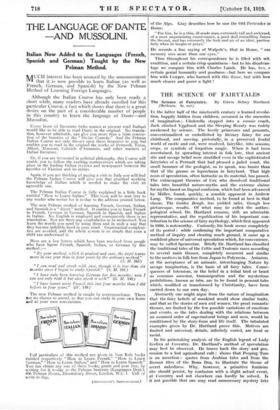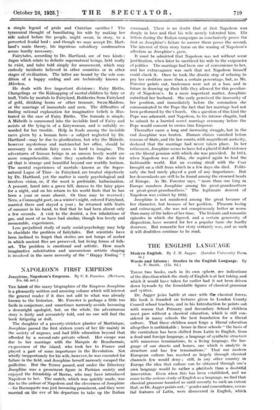THE SCIENCE OF FAIRYTALES
The Science of Fairytales. By Edwin Sidney Hartland. (Methuen. 6s. net).
IN the latter half of the nineteenth century a learned revolu- tion, happily hidden from children, occurred in the nurseries of imagination : Cinderella stepped into a cosmic coach, Jack climbed Yggdrasil and the Sleeping Beauty was rudely awakened by science. The lovely princesses and peasants,
conventionalized or embellished by literary fancy for our childhood, and moving, pictorially, in a preserved feudal
world of castle and cot, were resolved, fairylike, into seasons, crops, or symbols of forgotten magic. When it had been ascertained, by spreading interest in folk lore, that ancient rite and savage belief were stratified even in the sophisticated fairytales of a Perrault that had pleased a jaded court, the small hammer of the geologist, so to speak, was busier than that of the gnome or leprechaun in fairyland. That high noon of speculation, often fantastic as its material, has passed. The extravagant theories of Cox who dissolved traditional tales into beautiful nature-myths and the extreme claims for myths based on lingual confusion, which had been advanced by Muller, found, quickly, a sensible opponent in Andrew Lang. The comparative method, to be found at best in that classic, The Golden Bough, has yielded safer, though less picturesque, results. Of what may be called the anthro- pological school, Dr. Hartland remains, still, an admirable representative, and the republication of his important con- tribution to the science of fairy mythology, which first appeared in 1890, is noteworthy. Curiously, his book seems completely of its period : while confirming the important comparative method of inquiry and clearing much ground, it sums up a confident phase of universal speculation which, for convenience, may be called Spencerian. Briefly Dr. Hartland has classified the traditional tales of the Celtic and Teutonic races according to several main themes, completely recurrent and similar to the motives in folk lore from Japan to Polynesia. Animism, or the acceptance of an animate, interchanging Nature by savage imagination, is the basis of all fairy tales. Conse- quences of totemism, or the belief in a tribal bird or beast as common ancestor, transmigration and the mysterious prohibitions, known as tabu, are to be found in peasant tales which, modified or transformed by Christianity, have been carried down to our own day.
Abstractly one might argue from the nature of imagination that the fairy beliefs of mankind would show similar traits, and that as the stories of men and women, the great romantic themes, are limited by the few possible variations of emotions and events, so the tales dealing with the relations between an assumed order of supernatural beings and men, would be conditioned by the story-form and life itself. The tabulated examples given by Dr. Hartland prove this. Motives are limited and universal, details, infinitely varied, are local or racial.
In his painstaking analysis of the English legend of Lady Godiva at Coventry, Dr. Hartland's method of speculation may best be observed. He traces back the story and pro- cession to a lost agricultural cult : shows that Peeping Tom is an accretion : quotes from Arabian tales and from the Roman rites of the Bona Des, to illustrate the theme of secret nakedness. Why, however, a primitive feminine rite should persist, by confusion with a slight actual event, at Coventry and not elsewhere can hardly be solved. Is it not possible that one may read unnecessary mystery into a simple legend of pride and Christian sacrifice ? The tyrannical thought of humiliating his wife by making her ride naked before the people, might occur, in story, to a perverted feudal lord : and though we may accept Dr. Hart- land's main theory, his ingenious subsidiary confirmation seems hardly necessary.
Fairytales, according to Dr. Hartland, are of two kinds ; Sagas which relate to definite supernatural beings, held really to exist, and tales told simply for amusement, which may embody incidents believed in other countries or in other stages of civilization. The latter are bound by the sole con- dition of a happy ending and are technically known as Marchen.
He deals with five important divisions : Fairy Births, Changelings or the Kidnapping of mortal children by fairy or troll, Visits by mortals to Fairyland, Robberies from Fairyland of gold, drinking horns or other treasure, Swan-Maidens, or the marriage of immortals and men. The difficulties of finding rational explanation for imaginative beliefs is illus- trated in the case of Fairy Births. The formula is simple. A Midwife is summoned into the invisible land of Faery and assists at the lying-in of a fairywoman, and is suitably re- warded for her trouble. Help in feuds among the invisible races given by a human hero—a subject neglected by Dr. Hartland—may be due to glorification, but why the Midwife, however mysterious and matriarchal her office, should be necessary in certain fairy cases is hard to imagine. The adventures of human beings in an unseen lovely world are more comprehensible, since they symbolize the desire for all that is strange and beautiful beyond our worldly horizon. The mental experiences of mortals—known as the Super- natural Lapse of Time—in Fairyland, are treated objectively by Dr. Hartland, yet the matter is surely psychological and involves vision, or, if the word is preferable, hallucination. A peasant, lured into a green hill, dances to the fairy pipes for a night, and on his return to his world finds that he has been a year or more absent. Or time may be reversed ; Nera, a Connaught poet, on a winter's night, entered Fairyland, married there and stayed a year ; he returned with fruits of summer in his hand, to find that he had been absent only a few seconds. A visit to the dentist, a few inhalations of gas, and most of us have had similar, though less lovely and memorable, experiences.
Less prejudiced study of early social-psychology may help to elucidate the problem of fairytales. But scientists have been inclined to forget that stories are not lumps of amber in which ancient flies are preserved, but living forms of folk- art. The problem is emotional and artistic. How much imaginative substitution and unconscious artistic shaping is involved in the mere necessity of the " Happy Ending ?































































 Previous page
Previous page